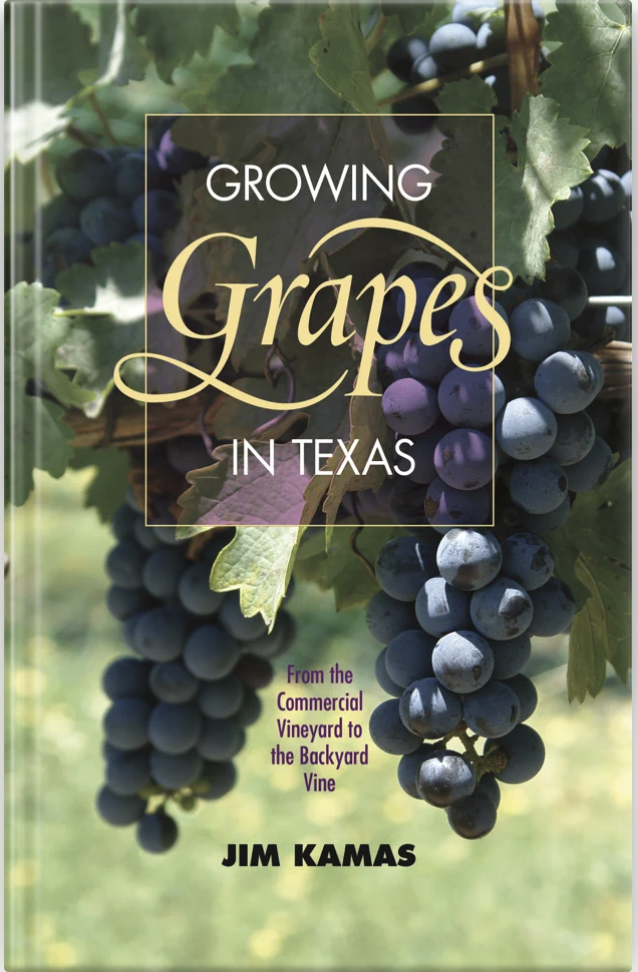Growing Grapes in Texas by Jim Kamas – a Book Review

Dallas County Master Gardener Trial Vineyards, Rowlett Road Extension

By Jim Kamas
Growing Grapes in Texas
Viticulture
Published: 2014
Pages: 250
When I moved to Dallas over two decades ago, I was surprised by the vastness and variation of terrain in the state. Arid microclimates in Dallas, sandy soil in east and south Texas as well as snow in the Northwestern portion of the state allow for extensive diversity in agriculture.
The larger wine industry is beginning to recognize the depth of variety and complexities that Texas winemakers share in each glass. There is an assumption, and understandably so, that most of the grapes are shipped into Texas for production. Many from outside the state are only familiar with wilting 100+ degree summers and hurricane season in the fall.
Farming in any state is not for the faint of the heart. Texas is no different. Jim Kamas has written a skillfully organized book, Growing Grapes in Texas. Kamas’ Texas A&M horticulture education, work with viticulture giants in Western New York and practical experience as an extension agent in Fredericksburg provide solid credentials to share practical knowledge with new entrants to vineyard management. Texas A&M University Press generously sent me a copy as a wine writer for review.
Growing Grapes in Texas walks the “knowledgeable” reader through major components of grape growing such as selecting a site, disease management, varietal selection and long-term management. I use the term “knowledgeable” reader because this book is a recommended read for someone who has taken an introductory horticulture course or intends to read it through once, take notes and then use it as part of studies in an approved viticulture program. Many of the terms are familiar to me as a Texas Master Gardener (16 weeks of 8-hour days studying horticulture were a great foundation). However, terms like “fungal wood management” may be new to many novice growers. The information is laid out in a logical manner with useful charts and graphs to illustrate key data points.
Instead of diving straight into the basics of site selection, pruning and disease management, Kamas asks the question that all potential grape growers need to ask themselves – Why?
There are no wrong reasons or answers. Experienced fruit farmers may chuckle at the question since they have a lifetime and perhaps family history in the challenges of going from idea to personal and even commercial success in agriculture. It is a question that should at least be given serious consideration. I highly recommend that anyone considering this venture seriously study this first chapter along with the next few on the history of viticulture in Texas. The beauty of the book is that Kamas uses a mere 34 pages to share insights that give a pragmatic viewpoint to guide even a novice.
If the realities of grape growing do not deter the reader from continuing with the book (and they shouldn’t because you would miss out on some great material), then Kamas dives into vineyard details such as site selection and design best used as a blueprint for the reader.
Growing Grapes in Texas goes into detail on the best varietal rootstocks for Texas microclimates. Common names, botanical names and native Texas rootstocks are identified as well as in-depth information on the formation of grapes from bud to ripeness. Planting, row spacing, canopy management and pruning data are presented so that experienced farmers can easily apply the information. Those who are using consultants will know enough to ask the right questions before major problems take hold in a vineyard.
I thoroughly enjoyed reading Growing Grapes in Texas. The book is laid out well, full of solid research and is designed for the serious student of vineyard management in this state. The book ends with a handy glossary that I’ve been able to go back to when researching other viticulture writings. For the serious student of viticulture or an individual who is thinking about embarking on the vineyard journey, this book is a must read for anyone considering a Texas locale.
Remember to drink what it is that makes you truly happy and always think positively!
Drink Responsibly!
@blackwinelovers @dallascountymaster gardeners texasmastergardeners texasa&mpress @texas extension agency @jim kamas @texas wine growers association
There is much more to learn about growing grapes than you can imagine.